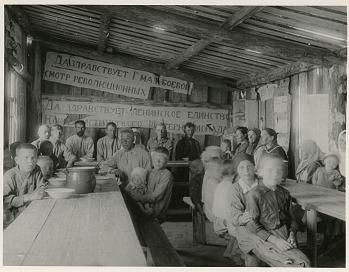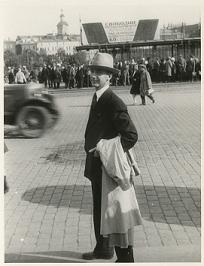Images from the Frank Whitson Fetter Collection
Frank Whitson Fetter’s photographs of daily life in the Soviet provinces represent an untapped resource to scholars working on a variety of topics, including Russian visual culture, the history of Soviet childhood and everyday life, as well as Russian-American cultural relations in the twentieth-century.
Frank Whitson Fetter (1899-1991), an American economist, university professor, and government advisor, traveled extensively throughout his lifetime, primarily on matters of business. In the summer of 1930, he visited two major cities in the Union of Soviet Socialist Republics. His first stop was Moscow, the capital of the Soviet Union and the Russian Soviet Socialist Federation, from which the Communist Party launched its First Five-Year Plan to industrialize the country and collectivize agriculture, irrespective of the massive social dislocation and organized state violence required to achieve its over-ambitious goals. However, after only two days in Moscow, “turning over stones <…> to no avail,” Fetter decided to ditch his Intourist guides and venture beyond the usual cities and towns on the official itinerary for foreign visitors. Instead, Fetter spent the bulk of his two-month trip in and around the city of Kazan, which was then the capitol of the Tatar Autonomous Soviet Socialist Republic and is today the capital city of the Russian Republic of Tatarstan.
 William Henry Chamberlin, a prominent historian of Russia, had warned Fetter in 1930 “that with the increasing severity of the Stalin regime, the Russians, even Communists in good standing, fearful for their own safety, were beginning to avoid social contacts with foreigners.” Undaunted, the forty-one-year-old American economist persevered and appears to have had little trouble befriending ordinary Soviet citizens. During his stay in the Soviet Union, he spent “six weeks with a Russian family in Kazan on the Upper Volga,” as he wrote, “in a very livable, although not pretentious room all to myself <…>, and with arrangements to take my meals at a boarding house next door and to take Russian lessons <…>. Of course there isn’t a radio in every room, or hot or cold running water by the bedside, but the place has electric lights, I can see the Volga from the drawing room of the boarding house, and Kazan is a quiet, and at the same time an almost interesting place.” He noted that “[t]he days in Kazan fly by rapidly and far from suffering from boredom in a place where I am the only American within several hundred miles, I find that when these long summer evenings come there are many things I meant to do that I didn’t do.”
William Henry Chamberlin, a prominent historian of Russia, had warned Fetter in 1930 “that with the increasing severity of the Stalin regime, the Russians, even Communists in good standing, fearful for their own safety, were beginning to avoid social contacts with foreigners.” Undaunted, the forty-one-year-old American economist persevered and appears to have had little trouble befriending ordinary Soviet citizens. During his stay in the Soviet Union, he spent “six weeks with a Russian family in Kazan on the Upper Volga,” as he wrote, “in a very livable, although not pretentious room all to myself <…>, and with arrangements to take my meals at a boarding house next door and to take Russian lessons <…>. Of course there isn’t a radio in every room, or hot or cold running water by the bedside, but the place has electric lights, I can see the Volga from the drawing room of the boarding house, and Kazan is a quiet, and at the same time an almost interesting place.” He noted that “[t]he days in Kazan fly by rapidly and far from suffering from boredom in a place where I am the only American within several hundred miles, I find that when these long summer evenings come there are many things I meant to do that I didn’t do.”
 Although Fetter arrived in Kazan precisely ten years after the official establishment of a Autonomous Tatar Soviet Socialist Republic, he appears to have had no firm itinerary or discernible purpose, besides a desire to record everything he could about his stay in first Socialist country in the world. An accomplished amateur photographer, Fetter eagerly documented his surroundings. He toured a veneer factory, a worker’s sanatorium, and the recently-organized “Voskhod” collective farm (photo below); visited parks, walked in the woods, swam in the Volga, and studied Russian with a private tutor. He was even able to take “a week’s trip down the Volga sharing a stateroom with a young Ukrainian journalist and his wife, who later made me one of the three principal characters in a somewhat fictionalized book about the trip.” Fetter also wrote many letters and saved notebooks and clippings. Like a good economist, he noted the prices and availability of goods such as strawberries and candy in the market lines for sugar and cigarettes, as well as the fact that Chinese women made paper toys for children in Kazan.
Although Fetter arrived in Kazan precisely ten years after the official establishment of a Autonomous Tatar Soviet Socialist Republic, he appears to have had no firm itinerary or discernible purpose, besides a desire to record everything he could about his stay in first Socialist country in the world. An accomplished amateur photographer, Fetter eagerly documented his surroundings. He toured a veneer factory, a worker’s sanatorium, and the recently-organized “Voskhod” collective farm (photo below); visited parks, walked in the woods, swam in the Volga, and studied Russian with a private tutor. He was even able to take “a week’s trip down the Volga sharing a stateroom with a young Ukrainian journalist and his wife, who later made me one of the three principal characters in a somewhat fictionalized book about the trip.” Fetter also wrote many letters and saved notebooks and clippings. Like a good economist, he noted the prices and availability of goods such as strawberries and candy in the market lines for sugar and cigarettes, as well as the fact that Chinese women made paper toys for children in Kazan.
 But it was photography that really excited Fetter. He fretted over his photos and told his wife that he would only feel he had reached his destination “when I and my photographic material get safely across the frontier.” It is these amateur photos — taken by an American economist in Kazan in 1930 and preserved at the David M. Rubenstein Rare Book & Manuscript Library at Duke University — that can be seen in this digital collection of images from the papers of Frank Whitson Fetter.
But it was photography that really excited Fetter. He fretted over his photos and told his wife that he would only feel he had reached his destination “when I and my photographic material get safely across the frontier.” It is these amateur photos — taken by an American economist in Kazan in 1930 and preserved at the David M. Rubenstein Rare Book & Manuscript Library at Duke University — that can be seen in this digital collection of images from the papers of Frank Whitson Fetter.
Text adapted from “Images of Soviet Children in the Frank Whitson Fetter Collection”–an unpublished paper delivered at the 2008 Southern Conference on Slavic Studies by Dr. Jacqueline Olich <jmolich@email.unc.edu>, Associate Director of the UNC Center for Slavic, Eurasian, and East European Studies. Quotations selected from Fetter’s unpublished personal correspondence and his article, “Russia Revisited: Impressions After Forty Years,” The South Atlantic Quarterly, Vol. LXXI, No. 1, Winter, 1972, pp. 62-74.


